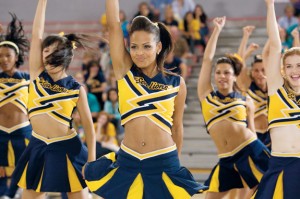why i can be both a cheerleader and a feminist
I have recently been accepted into Monash University’s Cheerleading team; a sport that has leapt and tumbled into notoriety through the likes of Bring It On and Glee. Images of attractive women adorned by short skirts and tight midriff tops in block colours like red and black have probably entered your cheer-tastic brain as you read this. They’re probably waving pom-poms, as their long hair brushes up against their skinny frame and fellow male class mates watch in a sexually frustrated gaze. If this applies to you, I’m going to ask you to take off those cheer-goggles and bring me a damn towel and some deodorant so I can wipe the sweat of my clammy face and rub my smelly underarms in your face after 3 hours of intense cardio practise in and un-air-conditioned 37 degree room.
Yesterday a close male friend asked me how it is that I identify so strongly as a feminist but am happy to run around in a tight lycra outfit ‘shaking my ass to the world’ and ‘kicking your legs so high they could see your vagina’. He had a point; when was the last time you saw or heard of a cheerleader not only with short hair but someone who regularly preaches ‘love your vagina’ to the world, attends international environment conferences and often muses over the evil patriarchal culture that we call life? Probably never, yet here I am. The introduction of cheerleading into Australian universities is a new and exciting outlet for athletes. Less than five years ago it would have been unheard of for major universities to be participating in national cheer competitions; twisting, pirouetting and jete-ing their way to state and national titles. No longer are dancers forced to watch their sporty classmates in envy as they throw, catch or kick balls at university games, because years of dance practise made them unable to execute any gross motor skills with remote agility apart from fouettes. We now have a competitive platform; that requires extreme discipline, fitness, flexibility and calf muscles to rival Arnold Schwarzenegger.
The real issue here is that despite competitive cheerleading avoiding football games or ‘cheering’ for a male dominated sport in Australia, a culture of sexualised stereotypes still lingers around the word and concept of ‘cheerleading’. If only the rest of the world could take a big old whiff of a training room once 25 girls have completed 180 minutes of cardio – it definitely ain’t a cheery aroma. You’d almost need an industrial sham-wow to soak up the amount of sticky sweat that these athletes produce. Now did someone say sexy? I sure as hell don’t feel it after training or as I awkwardly attempt a calypso jump and fail to launch off the sweaty floors.
But I certainly do feel sexy and like a real woman whenever I reach my long term goal of left leg splits or waking up in the morning after a training session and knowing that exercise stabilises my mental health, provides opportunity for friendship and builds skills in team work and listening.
If that isn’t feminism, then I don’t know what is. I see feminism as having respect and freedom for the choices that other women and I make. If I were to start cheerleading so men or other women would find me attractive in a short skirt and top in a bid to fill some form of insecurity, then I would retract my statement as a feminist, but that does not necessarily mean women who join for those reasons cannot identify as feminists either. When it eventually comes time to squeeze into my royal blue skirt and skin tight top I will wear it with pride knowing that my team mates and I wear it for ourselves and the greater good of the team – dismissing an age old, over sexualised cheer-misrepresentation.
Now someone bring me some deodorant and a cheeseburger STAT!



Lou! This is a really good point. And this piece is really really well written and entertaining. Well done!
And as a dancer my self, I agree with Lou. The costumes I have worn may seem ‘sexy’, but that’s only if you look at it with a purely aesthetic view. The costumes are designed to make the lines look better in order to enhance the expressive value of a piece. Leotards may be revealing, but they were not designed to attract male attention, but to make a reveal a beautiful and expressive body.